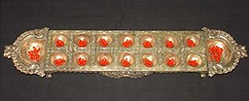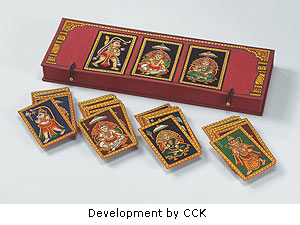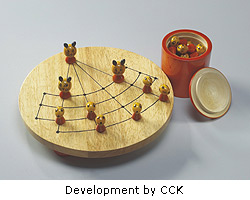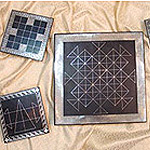Annual summer vacations in my grandparents’ home, in Gobichettipalayam, a small town in Tamil Nadu, to which my paternal kannadiga ancestors had migrated was a world, completely apart, from our normal convent-school-centered childhood. Walking barefoot in the theruvus, streets, swimming in the vaykal, canal, making cow-dung cakes and playing traditional games, were new experiences. In contrast to hockey, basketball and seven tiles, the games we were accustomed to, we learnt the nuances of eidu kallinnna atta (five stones) kunte bille ( hopscotch) and board games like alugulimanne (also known as pallanguli in Tamil). My sister and I counted tamarind seeds in the seven pits of a double rowed, beautifully carved, folding wooden board. Substituting for the seeds, were sometimes, cowrie shells or orange colored annatto seeds. Visits to relatives in Nanjangud and Bangalore introduced us to other traditional board games, like huli kuriatta (tigers and goats) and chowkabara, a race game. These were and are, in the predominantly agrarian societies of India, leisure pastimes, played by young and old.
World over, board games were as significant as trade and religion, for transmitting cultural forms and ideas. As objects of art, they were treasured possessions and status symbols, often finely crafted and elaborately decorated to reflect the aspirations of their owners.
Mysore, under Mummadi Krishnaraj Wodeyar 111(1794-1868) was a hub, for creative expressions of arts and crafts and a centre for producing games, pawns and dice. Kautuka Nidhi, one of the nine chapters on “ Sports and Pastimes”, part of the encyclopedic work Sritatwanidhi (“Noble Treasury of Philosophy” ) compiled under the patronage of Mummadi, describes the various board and card games of the era. Krishnaraja was a man given to religious and astrological speculation and the walls of the Jaganmohan Palace of Mysore, are covered with paintings of astrological charts and tables and an endless series of board, dice and card games.
Kreeda Kaushalya is a laudable initiative by Mysuru based crafts foundation Ramsons Kala Pratishthana, to research and revive the traditional board games of Karnataka, using the living, crafts traditions of the State.
Navalgund Game Board Dhurry
 |
Navalgund is a small town 40 kms from Hubballi (Hubli) in Dharwad district of Karnataka, once known for its navilu-gundas, or ‘peacock groves’. The exotic peacock is the inspiration for the design of the vibrant Navalgund cotton dhurry or ‘ jamakhana” woven in this town, in pit looms, traditionally by women weavers from the Muslim community.The designs are geometrical, embellished with floral and bird motifs. Till not very long ago a ‘char-mor’ jamakhana, with saada phool, geometrical floral forms and four stylized peacocks, with the pachisi or, pagade atta, woven in the centre, was part of the bridal trousseau and also pledged to secure loans.
The team of designers from Ramsons have revived this unique floor covering cum board game.
 |
Algulimanne
 |
This is a brass alguli manne or mancala board crafted using the ‘cire purdue’ or lost wax process. Along with regular double rows of seven pits, the board has two larger storage pits, bordered by a prabhavali, arch, topped by a keerthimukha, lion face. The two sides have been intricately crafted with the motif of the mythical double headed eagle, gandaberunda in the centre. The board stands on four legs moulded into lion motifs.
Game Boards in Bidri Craft
Bidricraft, originated in Bidar in Northern Karnataka is a craft of damascening or inlaying silver onto a dark metal plate made from an alloy of zinc, copper, tin and lead. Tarkashi is the art of inlaying silver wire whereas Tainishan is the craft of – inlaying silver sheets. The game board in the centre is the game ‘’Elephants and Men’ ,with the border beautifully inlaid in the famous ‘phuljari’ design.
 |
Several organisations like and The Crafts Council of Karnataka has also been independently working on traditional board games of Karnataka. CCK has replicated for the first time one of the 13 Mysore Chada or card games – the Navin Rama Chada with 36 cards.
 |
 |
Ansuya Pavanje, Founder Secretary of CCK had a sample of a beautiful round shaped version of huli kuri atta, with pawns of tigers and sheep made in natural dyed, lacquered hale wood, made by her father, the eminent Karnataka artist Pavanje. This has been revived by CCK and beautifully executed by craftsperson
Kauser of Channapatna
Chauka Bara is a ‘Race Game’ where in two to four players race their respective coins on a board of 5×5 squares to reach the inner most square. The movement of coins is controlled by throw of four cowrie shells, hence it is a game of chance. Since each player has four coins, he can decide which coin to move, hence it also a game of strategy race game. CCk has developed a chaukabara board game in the craft of Chittara, the mural tradition of the Shivamogga region of Karnataka, executed by state award winner Radha Sullur.
 |
There are several benefits of playing board games. Board games are played to improve memory, counting skills and honing strategy. For children weak in mathematics and lacking concentration, Aliguli Mane (Mancala) is a traditional antidote. Alignment games like Nava Kankari will help unclutter the mind. Hunt games like Adu Huli and Aney Kattu enable kids to develop a killer instinct to succeed. Race games like Pagade, Chauka Bara and >Panchi, improve the competitive spirit.
Gallery
YOUR VIEWS
PRACTITIONERS: INDIA
Access 70,000+ practitioners in 2500+ crafts across India.
BIBLIOGRAPHY
10,000+ listings on arts, crafts, design, heritage, culture etc.
GLOSSARY
Rich and often unfamiliar vocabulary of crafts and textiles.
SHOP at India InCH
Needs to be written.






